Those who know me, are aware of my passion for research on Walt Disney. This research has many forms–my favorite being historical documents, or in the more academic intellectual pedantic psycho-babble 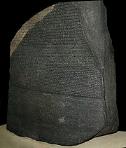 terminology, “primary resource material”: Correspondence, Inter-Office Communication, Transcripts, Meeting Notes, Journals, Diaries, Legal Documents, Plans, Reports, Manuscripts, and so forth. The value of this type of material (historical, not monetary) simply can not be overstated! Major historical breakthroughs are almost always a result of this type of material (think Rosetta Stone). I believe that is why this kind of material quickly became my favorite in my O.C.D. compulsion to collect, acquire, and learn anything and everything about the Walt Disney legacy and its inner workings.
terminology, “primary resource material”: Correspondence, Inter-Office Communication, Transcripts, Meeting Notes, Journals, Diaries, Legal Documents, Plans, Reports, Manuscripts, and so forth. The value of this type of material (historical, not monetary) simply can not be overstated! Major historical breakthroughs are almost always a result of this type of material (think Rosetta Stone). I believe that is why this kind of material quickly became my favorite in my O.C.D. compulsion to collect, acquire, and learn anything and everything about the Walt Disney legacy and its inner workings.
As many of you know, I am also quite fond of oral histories (i.e., interviews with those people that were actually “there”). As a Disney historian, this has become all but impossible these days (putting us into the realm of Civil War historians), as many of those wonderful, creative people that worked with Walt have sadly left us. Unfortunately, academia (yes, lower case a) sort of looks down upon this type of history, often citing the fact that memories can be faulty. Yet, they seem to forget, that in essence, all history is, or was, at first oral–even primary research material is often still someone’s opinion or recollection.
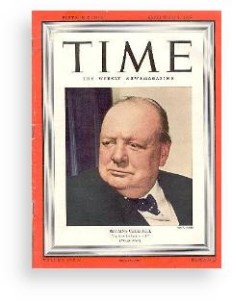 When dealing with visual (and visceral) art forms, such as all that Walt dabbled in, the above two types of research are probably the least exciting, offering little to no aesthetic or visually pleasing elements. To me, if there was such a title as this (that is, in the great Pantheon of all that is Disney history) it would be reserved for the thousands of vintage magazines featuring Disney artwork on the cover, often created exclusively for a specific periodical (assuming one’s name was in the realm of Life, Look, Saturday Evening Post, and so forth). Typically the cover was just a tease for what lay inside: often more Disney art, behind-the-scenes photos, information on the topic, and, if we were really lucky, a few choice quotes from Walt or some of the artists. During Walt’s lifetime, magazine publicity was one of the key elements used by movie studios for promotion.With the Disney promotion always being so visually based, it was only natural that publicity campaigns were often centered around periodicals were their glossy full-color covers.
When dealing with visual (and visceral) art forms, such as all that Walt dabbled in, the above two types of research are probably the least exciting, offering little to no aesthetic or visually pleasing elements. To me, if there was such a title as this (that is, in the great Pantheon of all that is Disney history) it would be reserved for the thousands of vintage magazines featuring Disney artwork on the cover, often created exclusively for a specific periodical (assuming one’s name was in the realm of Life, Look, Saturday Evening Post, and so forth). Typically the cover was just a tease for what lay inside: often more Disney art, behind-the-scenes photos, information on the topic, and, if we were really lucky, a few choice quotes from Walt or some of the artists. During Walt’s lifetime, magazine publicity was one of the key elements used by movie studios for promotion.With the Disney promotion always being so visually based, it was only natural that publicity campaigns were often centered around periodicals were their glossy full-color covers.
For exploitation (the distribution term for the publicity campaign to promote a film) magazines were often the preferred choice, followed closely by radio, movie trailers, and individual movie theater promotions. Today, you can’t flip on a dial of any kind (including your “computer dial”), without hearing, seeing, or experiencing a commercial for the latest and greatest movie release. During most of the era Walt was making films, the “dial” to the movie viewing public was the magazine, which brings me to easily the most pleasing “form” of Disney research. Beyond their pure beauty, I also learned, early in my Disney history career, what a valuable research tool they could be as well. As such, I was very aggressive in my search for these wonderful tomes, and as of this current date, I have over 4700 of them in my database (all pre-1967), with at least a fifth of these having Disney covers (photo or artwork). At one time I proposed an art book featuring the story of this type of exploitation, along with a selection of maybe the best 50 to 75 covers of all time. As of this writing, I have not found a publisher, but I haven’t given up. And so, with this lengthy post (is there any other kind?) I want to launch this aspect on my blog, featuring various Disney covers on magazines. I’ll tag these as two different kinds, the Walt cover (Magazine: Walt) and the standard artwork cover (Magazine: Disney).
For this first “magazine” post I debated long and hard on what should be the first one–after all, I have so many favorites (probably the 1937 Colliers, if I was on a desert island and had to choose). And then, rather than pick amongst the many favorites, I decided to just post the most recent addition 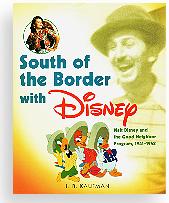 to my research collection. It was acquired from an independent bookseller (in Eastern Europe, of all places!), but hails from Argentina. Dated July 15, 1953, it features a Walt cover (one of my favorite types of magazines – as often Walt would do a sitting just for a specific periodical). While dated 1953, the Walt on the cover has a 1940s look (check out that great tie – that directly ties [pun intended] in with his article on animals, so perhaps it is contemporary to the magazine). As such, makes me wonder if perhaps this was taken during Walt’s work for the Coordinator for Inter-American Affairs! (And a quick commercial, if you have not purchased J.B. Kaufman’s ground-breaking book, South of the Border With Disney, I suggest you do so! And a quick commercial for this blog, JB will be here in Salt Lake City in the next six weeks or so, and has agreed to sit down with me and do an extensive interview on the topic for this blog–something to look forward to). To order this book now click on: South of the Border With Disney: Walt Disney and the Good Neighbor Program, 1941-1948
to my research collection. It was acquired from an independent bookseller (in Eastern Europe, of all places!), but hails from Argentina. Dated July 15, 1953, it features a Walt cover (one of my favorite types of magazines – as often Walt would do a sitting just for a specific periodical). While dated 1953, the Walt on the cover has a 1940s look (check out that great tie – that directly ties [pun intended] in with his article on animals, so perhaps it is contemporary to the magazine). As such, makes me wonder if perhaps this was taken during Walt’s work for the Coordinator for Inter-American Affairs! (And a quick commercial, if you have not purchased J.B. Kaufman’s ground-breaking book, South of the Border With Disney, I suggest you do so! And a quick commercial for this blog, JB will be here in Salt Lake City in the next six weeks or so, and has agreed to sit down with me and do an extensive interview on the topic for this blog–something to look forward to). To order this book now click on: South of the Border With Disney: Walt Disney and the Good Neighbor Program, 1941-1948 If you want a signed copy, I am going to have J.B. sign a dozen or so copies and will be selling them for retail plus shipping (to order a signed copy of South of the Border). Either way, if you are reading the Disney History Institute site (and truly have made it this far), then this book is for you. It will be a must have tome for your “Complete Disney History Shelf Of Books”!!
And now, the magazine!
The article inside is ten pages, with one more photo of Walt (in front of CIAA storyboards, again leading me to believe that the cover was taken during the South American trip–however, looking over Walt’s shoulder is a distinctively Fifties Mickey Mouse, probably added in 1953). As stated on the cover, the article on animals is “written” by Walt Disney (which 99 times out of a 100 was a publicity man, but often Walt did approve the essay). There is also a photo essay on Eva Peron, and ironically, an article on Salvador Dali (who just several years before the appearance of this magazine had been working on Destino at the Disney Studios). My hope is to twist the arm of my good friend Didier Ghez and get a translation of the article (like poor Didier doesn’t have enough to do–and if you are not familiar with his blog, you should go here: Didier’s Most Brilliant Disney History Blog).
So, in the future, watch for more Disney magazine covers.
Endnotes and Citations can be seen at: endnotes.

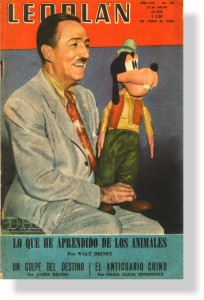
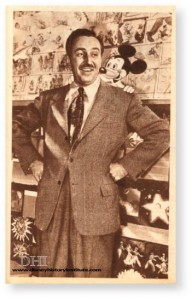
Hi, I am a big disney fan and found your blog linked at another Disney blog, it most came to my attention the Argentina note as I am from Argentina 🙂
here is well known that Walt loved our BBQ (Asado as we call it) and that he was inspired by a wood in Bariloche, in the patagonia, to write Bambi.
nice reading your blog, thanks for all the information, I really enjoyed it
Ana